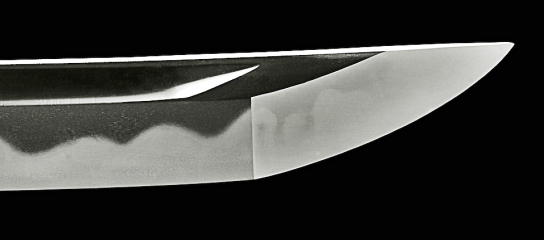Wakizashi TAMAHAGANE
This range of wakizashi begins with the T10 / C105 hamon (more information). These are high-end marus that have undergone heat treatment. Indeed, a mixture of clay is applied to the blade, not very thick at the edge. This is heated to 1472°F before soaking it in water.

Find our catalog at the bottom of this page
This sudden cooling forms martensite where the thin clay cannot protect the blade. Thus, the edge becomes extremely hard, keeping the rest of the blade softer, in order to absorb the blows always as effectively. These blades can be much better sharpened. The hamon is easily visible, it forms a line at the edge (see the photograph)

Finally, the last wakizashis are the Tamahaganes. Tamahagane steel is produced in Shimane, Japan, a region known for its ferruginous sand which contains a lot of molybdenum (preventing katana breakage) and very little phosphorus (having the opposite effect in a way). It was the traditional steel which today has become extremely rare. There are in a way three types of modern Tamahagane: the one produced outside Japan, with katanas generally costing between 2000-2500 euros (those on this page), a modern Tamahagane too, but produced in Japan (we have been making some since our forges in Seki but only on request by email), and finally the Tamahagane from the tatara scabbard rehabilitated by the NBTHK. Once again for the latter, we only do this on request. Obviously, we do not do more traditional and more efficient.
Shipping 12 weeks

From where are coming our sabers ?
Our Wakizashi all come from our forges where experienced craftsmen who have dedicated themselves for several decades to the creation of Japanese swords, give free rein to their imagination. We scrupulously check that each of our Wakizashi is forged in the rules of the art. In addition, our high quality Wakizashi are all forged by blacksmiths with at least twenty years of experience.Of course, they are not nihontos (Wakizashi of great masters from Japan) whose prices can reach several tens of thousands. euros. Tsubas are made from molds, and rites to include a soul in Wakizashi are not performed. We offer this kind of Wakizashi (real Shinsakuto) in the "Articles / Nihonto" section. However, we ensure a controlled manufacturing, combining ancient and modern processes, respecting what Wakizashi represents: the materials are detailed on the cards of our swords, and the polishing is certainly carried out by hand, but with stones like it should, and not a grinder ("hand grinder" is a fun but all too common feature of practice Wakizashi).

Shipping 12 weeks
To know more thanks to our two videos :
.








